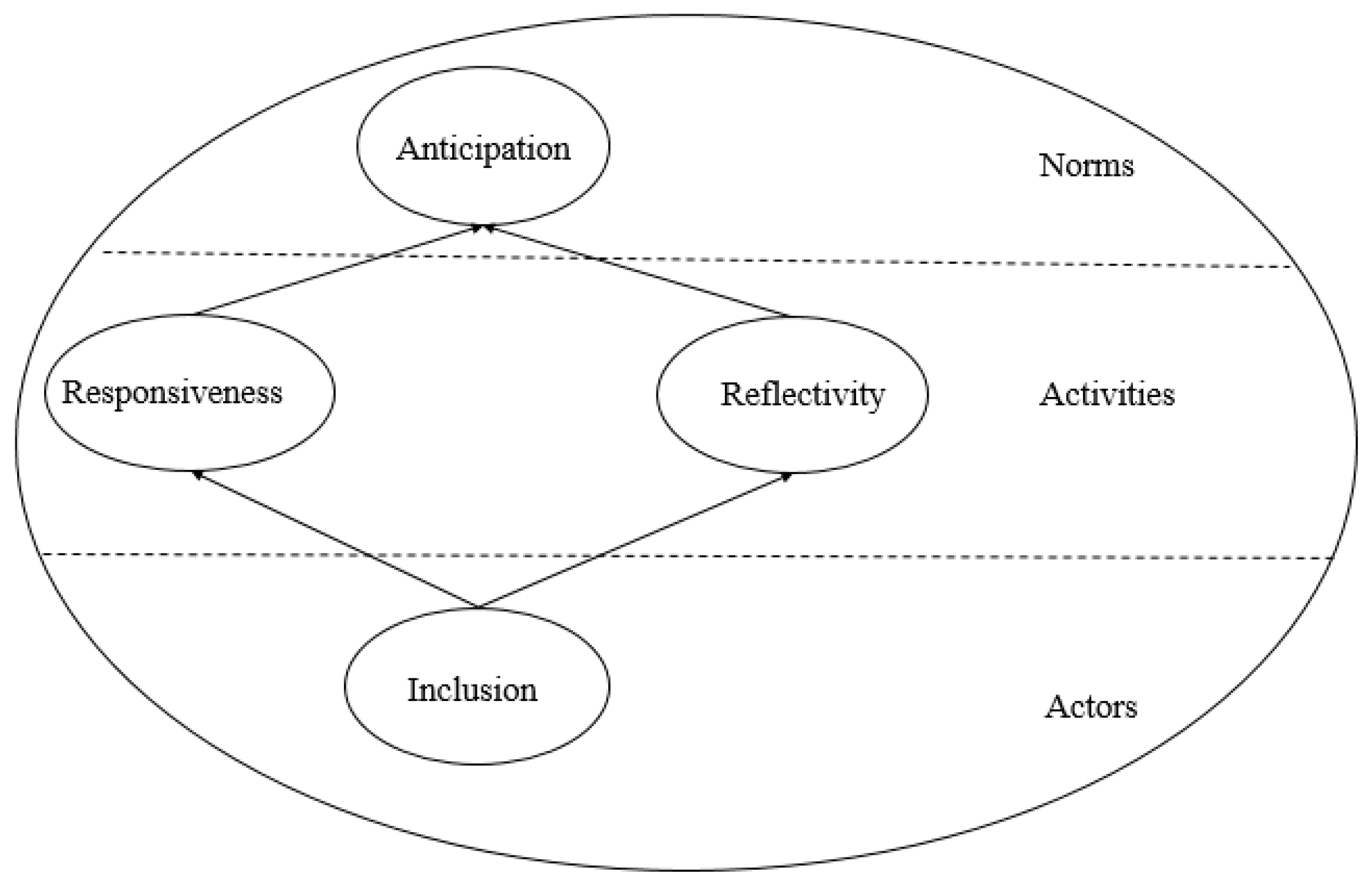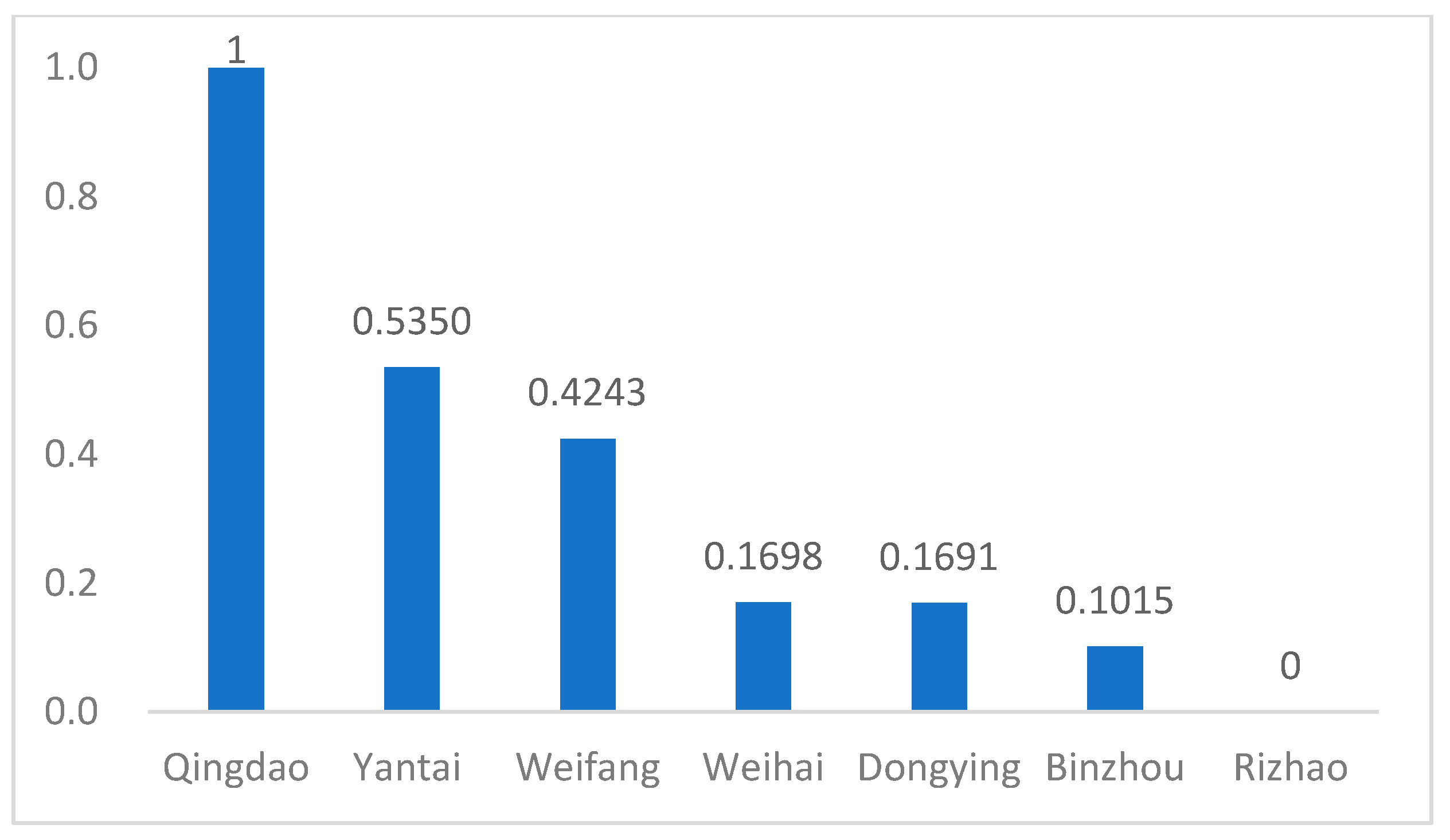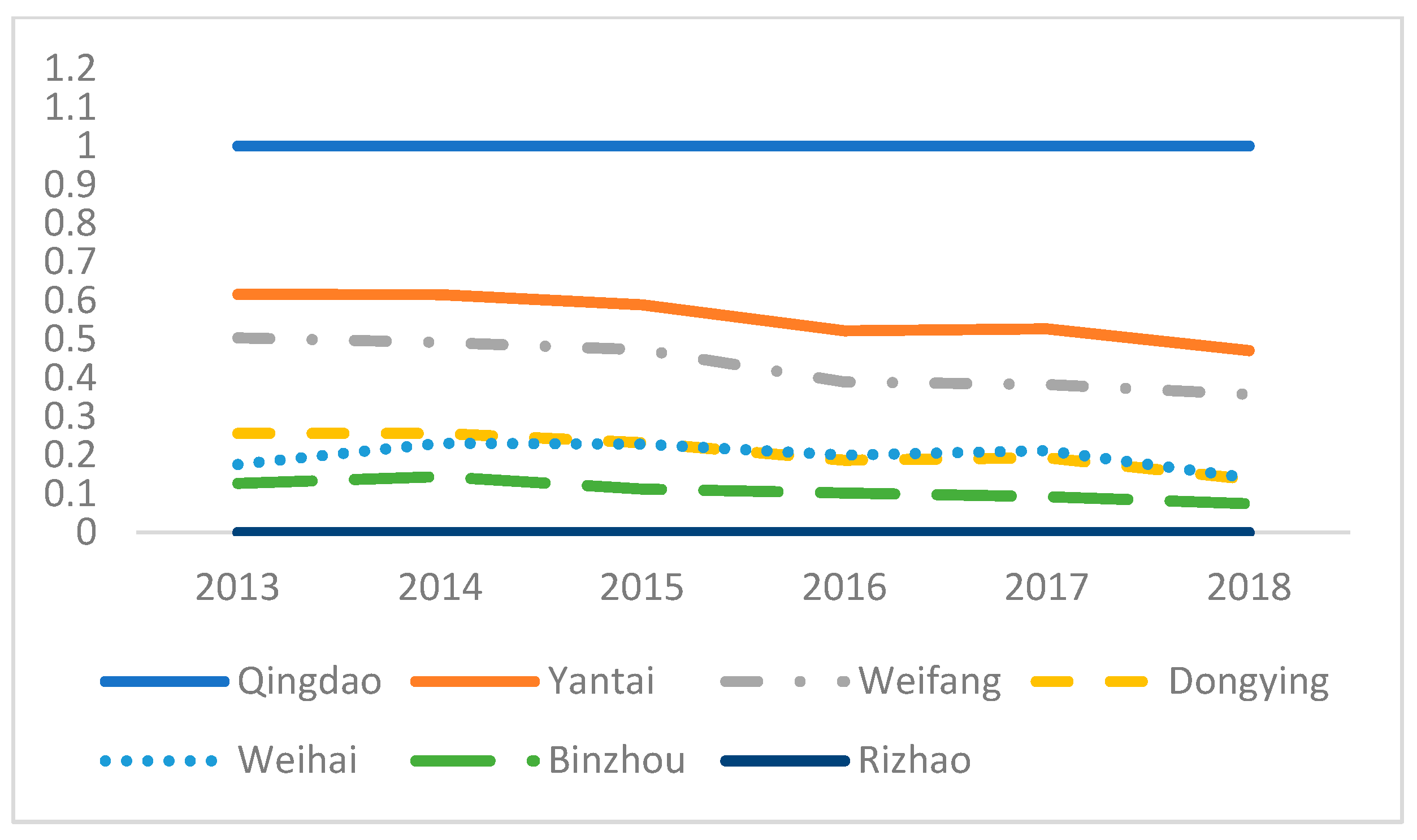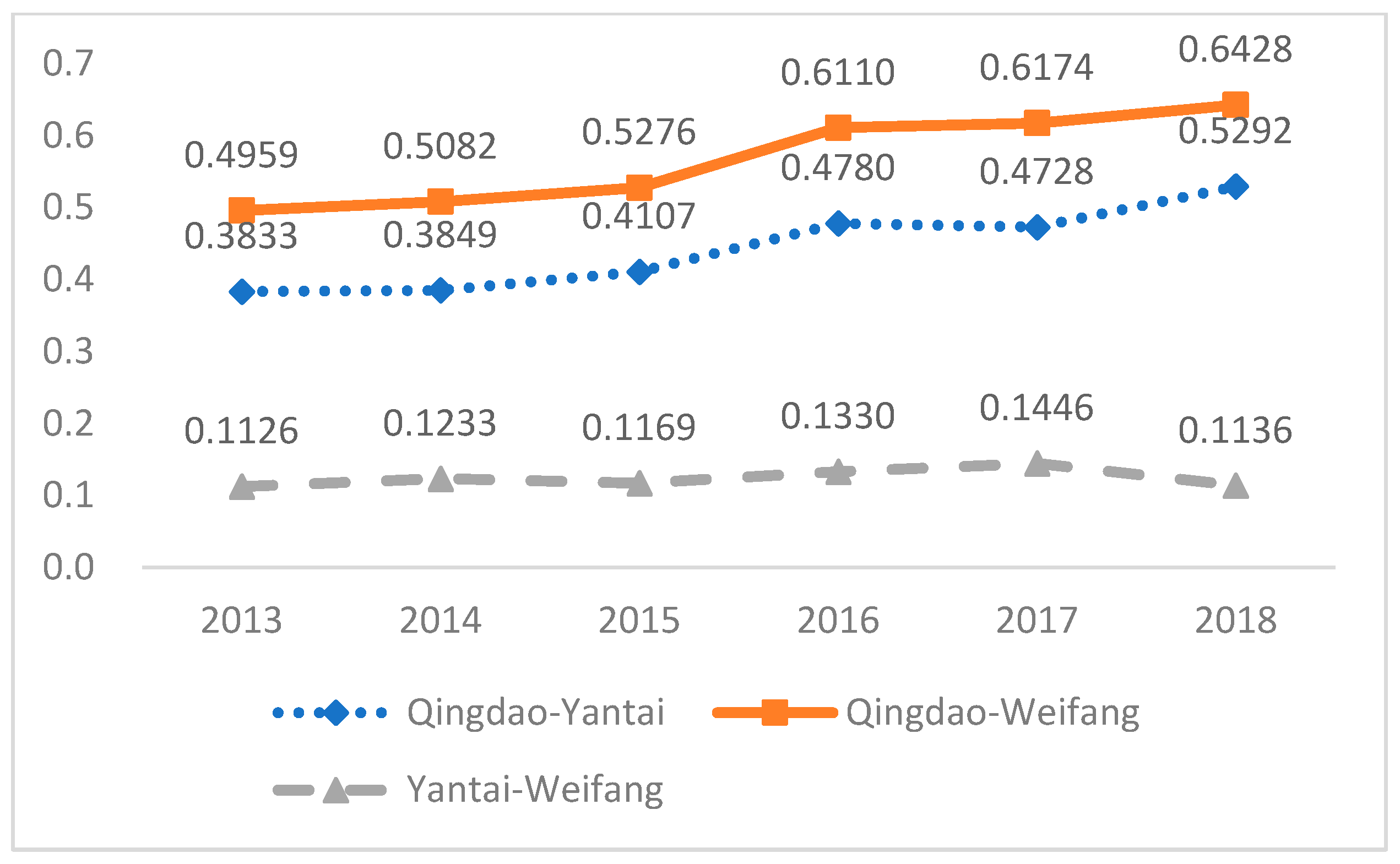Research on Responsible Innovation Performance Evaluation in the Blue Economic Zone of Marine Industry
Abstract
1. Introduction
2. The Connotation and System of Responsible Innovation Theory
2.1. The Connotation of Responsible Innovation Theory
- (1)
- The theory of “responsible innovation” is centered on human behaviors and activities with innovative characteristics. By embedding “responsibility” demands into the process and various aspects of innovation, its extension involves theoretical innovation, institutional innovation, cultural innovation, technological innovation, etc. [18,19,20].
- (2)
- Technological innovation is an indispensable path to achieve sustainable development, but technological innovation may also cause harmful consequences. Therefore, the combination of responsibility and innovation is an important strategic path to achieve sustainable development for a “better tomorrow” [21].
- (3)
- The high risks implied by technological innovation and the vicious consequences of technological abuse and misuse have caused people’s distrust of technological innovation and even the government, enterprises, scientific research institutes and other innovation entities and governance entities [22,23].
- (4)
2.2. Theoretical System of Responsible Innovation
3. Responsible Innovation Performance Evaluation System for the Blue Economic Zone
- (1)
- Actors in responsible innovation. Actors in responsible innovation represent the input factor in the responsible innovation process. If there are many input factors and relatively more innovative activities, the results will be more ideal. Input factors include human resources, material resources, financial resources, information resources, relationship resources, etc. Different combinations of resources yield considerable differences in the process and results of the relationship. However, material resources, information resources, and relationship resources are numerous and difficult to quantify and obtain. With reference to previous studies, combined with the needs of this research, resource inputs are investigated from human resources, capital, resources, and other dimensions. Human resource input uses the full-time equivalence of R&D personnel and full-time equivalence of R&D personnel in industrial enterprises above a designated size. Capital input chooses general public budget expenditures, R&D expenses and R&D expenses in industrial enterprises above a designated size. The resource input chooses the power consumption.
- (2)
- Responsible innovation activities. Innovation activities represent the process and results of activities occurring between innovation elements. The essence of management lies in the division of labor and integration. If the ability to integrate resources is strong, the result of innovation activities, namely, innovation performance, will be ideal. Considering that management factors and data are difficult to quantify and obtain, the indicators of responsible innovation activities in the Blue Economic Zone are examined from the output dimension. Referring to the research process of related scholars, combined with the needs of this research, patent, standardization, foreign trade and capital output are common index contents. Combined with the reasonability of data, patents choose the number of three types of patent applications in China and the number of three types of granted patents in China. Standardization chooses high-quality provinces and the implementation and standardization tasks of brand strategies. Foreign trade chooses the gross import value and gross output value. Capital output chooses revenue in the general public budgets and the main business income of industrial enterprises above a designated size.
- (3)
- Normative foundations of responsible innovation. Normative foundations of responsible innovation represent the environment in which innovation actors, innovation activities and innovation results occur. Social, economic, and environmental factors are all included in responsible innovation norms. However, under different environmental backgrounds, there are obvious differences in innovation actors, innovation activities, and innovation results. The environment for responsible innovation in the Blue Economic Zone involves economic conditions and information exchanges. With reference to the research process of relevant scholars, combined with the needs of this research, economic indexes include per capita GDP, household consumption level and total wages of employees in urban units. Social insurance indexes choose retirement insurance benefits, basic endowment insurance of residents and number of health institutions. Information exchange chooses enterprise informatization and e-commerce level as the measurement indexes of responsible innovation norms.
4. Responsible Innovation Performance Evaluation of the Blue Economic Zone
4.1. Evaluation Method
4.2. Evaluation Results
5. Conclusion and Insights
5.1. Theoretical Significance
- (1)
- The four-dimensional model and three-dimensional model of responsible innovation are integrated, and a conceptual framework of responsible innovation in the blue economic zone is constructed. At present, no agreement on responsible innovation has been reached in academic circles. This study deems that the three-dimensional model and four-dimensional model are essentially consistent. Responsible innovation covers the overall framework of the actors—activities—norms. Responsible innovation performance in the blue economic zone shall contain the logic framework of input—transformation—output.
- (2)
- Based on the overall framework of the actors—activities—norms, the performance evaluation index system of innovation performance in the blue economic zone is built by PCA. This index system has three dimensions and involves 21 indexes. Specifically, the responsible innovation elements of actors include human resource input, capital input and resource input. The responsible innovation activity includes patent, standardization, foreign trade and capital incomes. The responsible innovation norms include economic conditions, social insurance and information exchange.
- (3)
- The responsible innovation performance in the blue economic zone is evaluated using data from 7 regions from 2013 to 2018. As the process of establishing the index system follows the principles of being mutually exclusive and collectively exhaustive, the results prove the validity of the index system. In addition, it is found that the rank of regions in terms of comprehensive responsible innovation performance in the blue economic zone of the marine industry changed slightly, but the regional gap was expanding. In view of the time span, regions with high performance achieved higher performance, and regions with low performance achieved poorer performance. There is a “Matthew effect” in regional development.
5.2. Practical Significance
- (1)
- Increase input and pay attention to elements of actors in responsible innovation in the blue economic zone from the source. As a directional behavior, innovation involves not only correlations among the scientific community and scientific research institutes and social organizations but also conflict between the right to speak and comprehensive benefits. The stakeholders involved in responsible innovation development are diverse and are expected to share the associated responsibilities and risks. Responsible innovation is a huge systematic process that requires responsibility of the leader but also supports and participates in all social sectors, including government, universities, scientific institutions and social organizations.
- (2)
- Strengthen resource integration to assure high utilization of resources in the process. When perfecting the national innovation system, the government should further explore technological development strategies that conform to social needs, meet public expectations and realize the long-term win–win of stakeholders from the perspective of national innovation-driven development values. The value dimensions of innovation activities in public health and environmentally friendly aspects are recreated by responsible innovation. The social consequences of technological innovation, especially emerging technologies, are evaluated by constructive technological evaluation. Potential opportunities and threats are investigated systematically, and evaluations are feedback to the innovation process.
- (3)
- Paying attention to institutional innovation, building a long-term guarantee mechanism of responsible innovation, further perfecting laws and regulations about innovations, and determining the innovation management system and duties and properties of participating subjects in the blue economic zone through legislative forms are important tasks to assure innovation development in the blue economic zone. These are also beneficial to realize a uniform layout of innovative development in the blue economic zone, thus making local innovation management legalized and standard. It is suggested to build “responsible” management and service institutions for innovative development in the blue economic zone and provide one-stop services for innovation to assure the implementation of relevant innovation policies and regulations.
5.3. Limitations and Future Research
Author Contributions
Funding
Data Availability Statement
Conflicts of Interest
References
- Ma, H.R.; Steernberg, K.; Riera-Palou, X.; Tait, N. Well-to-wake energy and greenhouse gas analysis of SOX abatement options for the marine industry. Transp. Res. Part D Transp. Environ. 2012, 17, 301–308. [Google Scholar] [CrossRef]
- Carbajo, R.; Cabeza, L.F. Renewable energy research and technologies through responsible research and innovation looking glass: Reflexions, theoretical approaches and contemporary discourses. Appl. Energy 2018, 211, 792–808. [Google Scholar] [CrossRef]
- Guido, G. Voluntary measures, participation and fundamental rights in the governance of research and innovation: Reflections on a ‘constitutional’ model for Responsible Research and Innovation. ORBIT J. 2018, 1, 1–21. [Google Scholar] [CrossRef]
- Mei, L.; Rodríguez, H.; Chen, J. Responsible Innovation in the contexts of the European Union and China: Differences, challenges and opportunities. Glob. Transit. 2020, 2, 1–3. [Google Scholar] [CrossRef]
- Lovdal, N.; Neumann, F. Internationalization as a strategy to overcome industry barriers—An assessment of the marine energy industry. Energy Policy 2011, 39, 1093–1100. [Google Scholar] [CrossRef]
- Eizagirre, A.; Rodríguez, H.; Ibarra, A. Politicizing responsible innovation: Responsibility as inclusive governance. Int. J. Innov. Stud. 2017, 1, 20–36. [Google Scholar] [CrossRef]
- Setiawan, A.D. The influence of national culture on responsible innovation: A case of CO2 utilisation in Indonesia. Technol. Soc. 2020, 23, 101306. [Google Scholar] [CrossRef]
- Molla, F.S.; Line, B.; Harald, T.H. Practicing responsible research and innovation in a crowdsourcing project in Norway. ORBIT J. 2018, 2, 1–28. [Google Scholar] [CrossRef]
- Rosemann, A.; Molyneux-Hodgson, S. Industrial biotechnology: To what extent is responsible innovation on the agenda? Trends Biotechnol. 2020, 38, 5–7. [Google Scholar] [CrossRef]
- Castellucci, L. Economic assessments of the value of marine industries and services and user requirements. Elsevier Oceanogr. Ser. 2002, 66, 45–56. [Google Scholar]
- Koirala, B.P.; Van Oost, E.; Van Der Windt, H. Community energy storage: A responsible innovation towards a sustainable energy system? Appl. Energy 2018, 231, 570–585. [Google Scholar] [CrossRef]
- Genus, A.; Iskandarova, M. Responsible innovation: Its institutionalisation and a critique. Technol. Forecast. Soc. Chang. 2018, 128, 1–9. [Google Scholar] [CrossRef]
- Peng, D.M.; Hou, X.M.; Li, Y.; Mu, Y.T. The difference in development level of marine shellfish industry in 10 major producing countries. Mar. Policy 2019, 106, 103516. [Google Scholar] [CrossRef]
- Petraite, M.; Ceicyte, J. Conceptual model for responsible innovation management in business organizations. Procedia Soc. Behav. Sci. 2014, 156, 121–124. [Google Scholar] [CrossRef]
- Wang, Y.X.; Wang, N. The role of the marine industry in China’s national economy: An input–output analysis. Mar. Policy 2019, 99, 42–49. [Google Scholar] [CrossRef]
- Schillo, R.S.; Robinson, R.M. Inclusive innovation in developed countries: The who, what, why, and how. Technol. Innov. Manag. Rev. 2017, 7, 34–46. [Google Scholar] [CrossRef]
- Hellström, T. Systemic innovation and risk: Technology assessment and the challenge of responsible innovation. Technol. Soc. 2003, 25, 369–384. [Google Scholar] [CrossRef]
- Owen, R.; Goldberg, N. Responsible innovation: A pilot study with the U.K. engineering and physical sciences research council. Risk Anal. 2010, 30, 1699–1707. [Google Scholar] [CrossRef] [PubMed]
- Stahl, B.C.; Chatfield, K.; Holter, C.T.; Brem, A. Ethics in corporate research and development: Can responsible research and innovation approaches aid sustainability? J. Clean. Prod. 2019, 239, 118044. [Google Scholar] [CrossRef]
- Umbrello, S. Atomically precise manufacturing and responsible innovation: A value sensitive design approach to explorative nanophilosophy. Int. J. Technoethics 2019, 10, 1–21. [Google Scholar] [CrossRef]
- Loureiro, P.M.; Conceicao, C.P. Emerging patterns in the academic literature on responsible research and innovation. Technol. Soc. 2019, 58, 101148. [Google Scholar] [CrossRef]
- Pavie, X.; Carthy, D. Leveraging uncertainty: A practical approach to the integration of responsible innovation through design thinking. Procedia Soc. Behav. Sci. 2015, 213, 1040–1049. [Google Scholar] [CrossRef]
- Inigo, E.A.; Blok, V. Strengthening the socio-ethical foundations of the circular economy: Lessons from responsible research and innovation. J. Clean. Prod. 2019, 233, 280–291. [Google Scholar] [CrossRef]
- Lukovics, M.; Flipse, S.M.; Udvari, B.; Fisher, E. Responsible research and innovation in contrasting innovation environments: Socio-Technical Integration Research in Hungary and the Netherlands. Technol. Soc. 2017, 51, 172–182. [Google Scholar] [CrossRef]
- Hadj, T.B. Effects of corporate social responsibility towards stakeholders and environmental management on responsible innovation and competitiveness. J. Clean. Prod. 2019, 250, 119490. [Google Scholar] [CrossRef]
- Genus, A.; Stirling, A. Collingridge and the dilemma of control: Towards responsible and accountable innovation. Res. Policy 2018, 47, 61–69. [Google Scholar] [CrossRef]
- Bronson, K. Looking through a responsible innovation lens at uneven engagements with digital farming. NJAS Wagening. J. Life Sci. 2019, 90–91, 100294. [Google Scholar] [CrossRef]
- Owen, R.; Stilgoe, J.; Macnaghten, P.; Gorman, M.; Fisher, E.; Guston, D. A Framework for Responsible Innovation. In Responsible Innovation: Managing the Responsible Emergence of Science and Innovation in Society; Owen, R., Bessant, J., Heintz, M., Eds.; John Wiley & Sons Ltd.: Hoboken, NJ, USA, 2013; pp. 27–50. [Google Scholar]
- Stilgoe, J.; Owen, R.; Macnaghten, P. Developing a framework for responsible innovation. Res. Policy 2013, 42, 1568–1580. [Google Scholar] [CrossRef]
- Stemerding, D.; Betten, W.; Rerimassie, V.; Robaey, Z.; Kupper, F. Future making and responsible governance of innovation in synthetic biology. Futures 2019, 109, 213–226. [Google Scholar] [CrossRef]
- Steven, F. Using an ICT tool to stimulate multi-disciplinary innovation teams in establishing responsible research and innovation practices in industry. ORBIT J. 2018, 1, 1–13. [Google Scholar] [CrossRef]
- Stahl, B.C. Responsible research and innovation: The role of privacy in an emerging framework. Sci. Public Policy 2013, 40, 708–716. [Google Scholar] [CrossRef]
- Grasenick, K.; Guerrero, M. Responsible research and innovation & digital inclusiveness during Covid-19 crisis in the human brain project (HBP). J. Responsible Technol. 2020, 1, 100001. [Google Scholar] [CrossRef]
- Hemphill, T.A. The innovation governance dilemma: Alternatives to the precautionary principle. Technol. Soc. 2020, 63, 101381. [Google Scholar] [CrossRef]
- Buhmann, A.; Fieseler, C. Toward a deliberative framework for responsible innovation in artificial intelligence. Technol. Soc. 2021, 64, 101475. [Google Scholar] [CrossRef]
- Ko, K.C.; Nie, J.; Ran, R.; Gu, Y. Corporate social responsibility, social identity, and innovation performance in China. Pac. Basin Financ. J. 2020, 63, 101415. [Google Scholar] [CrossRef]
- Kwee, Z.; Yaghmaei, E.; Flipse, S. Responsible research and innovation in practice an exploratory assessment of Key Performance Indicators (KPIs) in a Nanomedicine Project. J. Responsible Technol. 2021, 5, 100008. [Google Scholar] [CrossRef]
- Sovacool, B.; Hess, D.J.; Cantoni, R. Energy transitions from the cradle to the grave: A meta-theoretical framework integrating responsible innovation, social practices, and energy justice. Energy Res. Soc. Sci. 2021, 75, 102027. [Google Scholar] [CrossRef]
- Zhang, Y.; Mao, Y.; Jiao, L.; Shuai, C.; Zhang, H. Eco-efficiency, eco-technology innovation and eco-well-being performance to improve global sustainable development. Environ. Impact Assess. Rev. 2021, 89, 106580. [Google Scholar] [CrossRef]
- Wang, Z.; He, Q.; Xia, S.; Sarpong, D.; Xiong, A.; Maas, G. Capacities of business incubator and regional innovation performance. Technol. Forecast. Soc. Chang. 2020, 158, 120125. [Google Scholar] [CrossRef]




| Level-1 Indexes | Level-2 Indexes | No. | Level-3 Indicators | Units | Hemphill [34] | Buhmann & Fieseler [35] | Ko et al. [36] | Kwee et al. [37] | Sovacool et al. [38] | Zhang et al. [39] | Wang et al. [40] |
|---|---|---|---|---|---|---|---|---|---|---|---|
| Actors in responsible innovation | Human resource input | f1 | Full-time equivalence of R&D personnel | Person/year | ✓ | ✓ | ✓ | ✓ | ✓ | ✓ | ✓ |
| f2 | Full-time equivalence of R&D personnel in industrial enterprises above the designated size | Person/year | ✓ | ✓ | ✓ | ✓ | ✓ | ✓ | ✓ | ||
| Capital input | f3 | General public budget expenditures | 10,000 yuan | ✓ | ✓ | ✓ | ✓ | ✓ | ✓ | ✓ | |
| f4 | R&D expenses | 10,000 yuan | ✓ | ✓ | ✓ | ✓ | ✓ | ✓ | ✓ | ||
| f5 | R&D expenses in industrial enterprises above designated size | 10,000 yuan | ✓ | ✓ | ✓ | ✓ | ✓ | ||||
| Resource input | f6 | Power consumption | 100 million kWh | ✓ | ✓ | ✓ | ✓ | ||||
| Responsible innovation activities | Patents | f7 | Number of three types of patent applications in China | pcs | ✓ | ✓ | ✓ | ✓ | |||
| f8 | Number of three types of granted patents in China | pcs | ✓ | ✓ | ✓ | ✓ | |||||
| Standardization | f9 | High-quality provinces and the implementation of brand strategies | pcs | ✓ | ✓ | ||||||
| f10 | Standardization | pcs | ✓ | ✓ | |||||||
| Foreign trade | f11 | Gross imports | 10,000 dollars | ✓ | ✓ | ||||||
| f12 | Gross outputs | 10,000 dollars | ✓ | ✓ | |||||||
| Capital output | f13 | General public budgets | 10,000 dollars | ✓ | ✓ | ✓ | ✓ | ✓ | |||
| f14 | Main business income of industrial enterprises above designated size | 100 million yuan | ✓ | ✓ | ✓ | ✓ | ✓ | ||||
| Normative foundations of responsible innovation | Economic conditions | f15 | Per capita GDP | yuan | ✓ | ✓ | ✓ | ✓ | ✓ | ||
| f16 | Household consumption level | yuan | ✓ | ✓ | ✓ | ✓ | ✓ | ||||
| f17 | Total wages of employees in urban units | 100 million yuan | ✓ | ✓ | ✓ | ✓ | ✓ | ||||
| Social security | f18 | Retirement insurance benefits | 10,000 yuan | ✓ | ✓ | ✓ | ✓ | ✓ | |||
| f19 | basic endowment insurance of residents | Person | ✓ | ✓ | ✓ | ✓ | ✓ | ||||
| f20 | number of health institutions | pcs | ✓ | ✓ | ✓ | ✓ | |||||
| Information exchange | f21 | Enterprise informatization and E-commerce level | 10,000 yuan | ✓ | ✓ | ✓ | ✓ | ✓ |
| Principal Component | Initial | Extracted | ||||
|---|---|---|---|---|---|---|
| Eigenvalue | Proportion | Cumulative | Eigenvalue | Proportion | Cumulative | |
| 1 | 14.9257 | 0.7107 | 0.7107 | 14.9257 | 0.7107 | 0.7107 |
| 2 | 2.5026 | 0.1192 | 0.8299 | 2.5026 | 0.1192 | 0.8299 |
| 3 | 1.8979 | 0.0904 | 0.9203 | 1.8979 | 0.0904 | 0.9203 |
| 4 | 0.9907 | 0.0472 | 0.9675 | |||
| 5 | 0.5123 | 0.0244 | 0.9919 | |||
| 6 | 0.1709 | 0.0081 | 1.0000 | |||
| Index (Variables) | No. | Principal Component 1 | Principal Component 2 | Principal Component 3 |
|---|---|---|---|---|
| fi | Component 1 | Component 2 | Component 3 | |
| Full-time equivalence of R&D personnel | f1 | 0.2563 | −0.0294 | 0.0202 |
| Full-time equivalence of R&D personnel in industrial enterprises above the designated size | f2 | 0.2500 | −0.1072 | 0.0571 |
| General public budget expenditures | f3 | 0.2524 | 0.0824 | −0.0721 |
| R&D expenses | f4 | 0.2543 | 0.0725 | 0.0477 |
| R&D expenses in industrial enterprises above designated size | f5 | 0.2487 | 0.0074 | 0.1011 |
| Power consumption | f6 | 0.1954 | −0.3694 | 0.0106 |
| Number of three types of patent applications in China | f7 | 0.2287 | 0.1466 | −0.1010 |
| Number of three types of granted patents in China | f8 | 0.2417 | 0.0102 | −0.0360 |
| High-quality provinces and the implementation of brand strategies | f9 | 0.2212 | −0.2712 | 0.0139 |
| Standardization | f10 | −0.1387 | −0.3167 | 0.4289 |
| Gross imports | f11 | 0.1225 | 0.2906 | −0.4943 |
| Gross outputs | f12 | 0.2406 | 0.1807 | −0.0911 |
| General public budgets | f13 | 0.2547 | 0.0780 | −0.0492 |
| Main business income of industrial enterprises above designated size | f14 | 0.2235 | −0.0239 | 0.2893 |
| Per capita GDP | f15 | 0.0042 | 0.3537 | 0.5076 |
| Household consumption level | f16 | 0.0375 | 0.3937 | 0.3781 |
| Total wages of employees in urban units | f17 | 0.2463 | 0.1213 | 0.1212 |
| Retirement insurance benefits | f18 | 0.2540 | 0.0752 | 0.0606 |
| Basic endowment insurance of residents | f19 | 0.1807 | −0.4434 | −0.0293 |
| Number of health institutions | f20 | 0.2319 | −0.1510 | 0.1475 |
| Enterprise informatization and E-commerce level | f21 | 0.2525 | 0.0071 | −0.0493 |
| Year | Region ➀ | Region ➁ | Region ➂ | Region ➃ | Region ➄ | Region ➅ | Region ➆ |
|---|---|---|---|---|---|---|---|
| 2013 | Qingdao | Yantai | Weifang | Dongying | Weihai | Binzhou | Rizhao |
| (1) | (0.6167) | (0.5041) | (0.2563) | (0.1761) | (0.1269) | (0) | |
| 2014 | Qingdao | Yantai | Weifang | Dongying | Weihai | Binzhou | Rizhao |
| (1) | (0.6151) | (0.4918) | (0.2559) | (0.2309) | (0.1444) | (0) | |
| 2015 | Qingdao | Yantai | Weifang | Dongying | Weihai | Binzhou | Rizhao |
| (1) | (0.5893) | (0.4724) | (0.2322) | (0.2285) | (0.1120) | (0) | |
| 2016 | Qingdao | Yantai | Weifang | Weihai | Dongying | Binzhou | Rizhao |
| (1) | (0.5220) | (0.3890) | (0.2002) | (0.1867) | (0.1018) | (0) | |
| 2017 | Qingdao | Yantai | Weifang | Weihai | Dongying | Binzhou | Rizhao |
| (1) | (0.5272) | (0.3826) | (0.2120) | (0.1933) | (0.0926) | (0) | |
| 2018 | Qingdao | Yantai | Weifang | Weihai | Dongying | Binzhou | Rizhao |
| (1) | (0.4708) | (0.3572) | (0.1407) | (0.1371) | (0.0747) | (0) | |
| Total | Qingdao | Yantai | Weifang | Weihai | Dongying | Binzhou | Rizhao |
| (1) | (0.5350) | (0.4243) | (0.1698) | (0.1691) | (0.1015) | (0) |
Disclaimer/Publisher’s Note: The statements, opinions and data contained in all publications are solely those of the individual author(s) and contributor(s) and not of MDPI and/or the editor(s). MDPI and/or the editor(s) disclaim responsibility for any injury to people or property resulting from any ideas, methods, instructions or products referred to in the content. |
© 2024 by the authors. Licensee MDPI, Basel, Switzerland. This article is an open access article distributed under the terms and conditions of the Creative Commons Attribution (CC BY) license (https://creativecommons.org/licenses/by/4.0/).
Share and Cite
Jiang, D.; Wang, S.; Chen, Z. Research on Responsible Innovation Performance Evaluation in the Blue Economic Zone of Marine Industry. Water 2024, 16, 2516. https://doi.org/10.3390/w16172516
Jiang D, Wang S, Chen Z. Research on Responsible Innovation Performance Evaluation in the Blue Economic Zone of Marine Industry. Water. 2024; 16(17):2516. https://doi.org/10.3390/w16172516
Chicago/Turabian StyleJiang, Daokui, Su Wang, and Zhuo Chen. 2024. "Research on Responsible Innovation Performance Evaluation in the Blue Economic Zone of Marine Industry" Water 16, no. 17: 2516. https://doi.org/10.3390/w16172516
APA StyleJiang, D., Wang, S., & Chen, Z. (2024). Research on Responsible Innovation Performance Evaluation in the Blue Economic Zone of Marine Industry. Water, 16(17), 2516. https://doi.org/10.3390/w16172516






